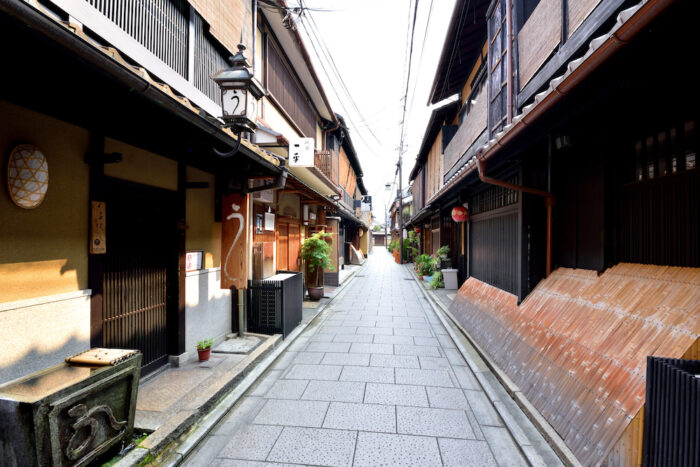
Kyoto
Kyoto is usually at the top of the list for tourists who are visiting Japan, and with good reasons. The historical capital city of Japan can seem like one big open-air museum with a wealth of historical treasures and neighborhoods. Because the city was spared in WW2, traditional Japan can truly be felt in Kyoto. It can be difficult to decide where to go when you are making plans to visit Kyoto, so we wrote this travel guide to help you!
With its history dating back to the 6th century, there are places of interest of all ages that can be visited. There are some world-famous highlights such as the Golden Pavillion and the Fushimi Inari. You can go to Gion to try and spot a maiko or geisha on her way to work. Some of the best traditional Japanese food can be had in Kyoto. If we can give you one tip, it would be to at least spend a few days in this wonderful city.
-

Machiya : Traditional Japanese Houses in Kyoto
A ‘machiya’ is a traditional wooden house that is especially typical of Kyoto city. It was the artisans and merchants of the cities who lived in machiya.
-

Nishiki Market | Kyoto Travel Guide
The best way to learn about everyday Japanese life and what people like to cook at home is to visit one of its many food markets. Nishiki Market is in the center of Kyoto, and a popular market to visit for tourists.
-

Byodoin Temple | Kyoto Travel Guide
The Byodoin temple is the most famous landmark in a part of Kyoto that is especially known for its green tea production, Uji. The image of the temple is very well-known throughout Japan.
-

Kodaiji Temple | Kyoto Travel Guide
Kodaiji Temple is located in Higashiyama. It was founded in 1605 by Kita-no-Mandokoro as a memorial to her husband, Toyotomi Hideyoshi, who was one of the most important men of his time.
-

Heian Jingu | Kyoto Travel Guide
The Heian Jingu shrine was instituted in 1895 to commemorate the 1,100-year anniversary of the return of the capital to Heian, which is today’s Kyoto. Its architecture is impressive.
-

Sanjusangendo | Kyoto Travel Guide
The Sanjusangendo temple in Kyoto was established by the powerful warrior-politician Taira-no-Kiyomori in 1164, and it is especially famous for its 1001 statues.
-

Gion | Kyoto Travel Guide
Gion is the place where the famous geisha, the cultural symbol of Japan, are still doing their work every night. Geisha literally means ‘artist’, although in Kyoto they are called ‘geiko’ which means ‘woman of art’.
-

Chionin Temple | Kyoto Travel Guide
The Chion-in temple in Kyoto is a Buddhist temple and is the home of Jo-do Buddhism. It was founded in the 12th century, and besides its historical significance, there are a few other reasons why this is an interesting temple to visit!
-

Tofukuji Temple | Kyoto Travel Guide
One of my favorite Zen temples is the Tofukuji temple located in the east of Kyoto city. What makes this temple very special are its magnificent landscapes of maple trees and cherry blossoms.
-

Kitano Tenmangu Shrine | Kyoto Travel Guide
The shrine of Kitano Tenmangu was built in the 10th century by the emperor of the time in honor of a scholar and politician. Now, it is especially known for its popular flea market.
-

Ryoanji Temple | Kyoto Travel Guide
Ryoan-ji is a Zen temple located in Kyoto which was built by a minister of the Ashikaga Shogunate in 1450. The temple is especially famous for its stone landscape garden.
-

Fushimi Inari Taisha | Kyoto Travel Guide
Known worldwide for its more than 10,000 torii gates in a row, the Fushimi Inari Taisha shrine attracts around 3 million visitors the first three days of the year alone and is one of the most famous attractions of Kyoto.
-

Toji Temple | Kyoto Travel Guide
Toji means Eastern Temple, and this temple in Kyoto has a very long history. The religious foundations of Kyoto were laid here, and Buddha has protected the city from where Kukai founded the temple since 796.
-

Ginkakuji Temple | Kyoto Travel Guide
Ginkakuji (Silver Pavilion) was constructed by a shogun from the 15th century. You can still see his quest for beauty in the Ginkakuji, even after 500 years.
-

Kyoto City | Kyoto Travel Guide
Kyoto is often called “the heart of Japan” and it is said that it would be impossible to get to know the country without visiting this wonderful city.
